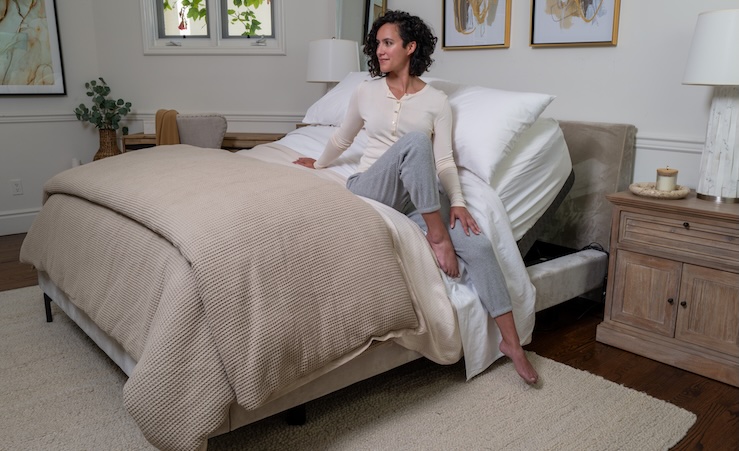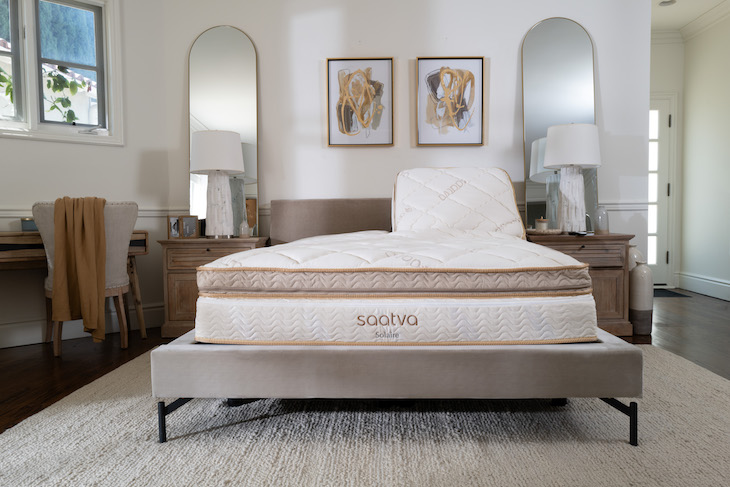There are quite a few sneaky daily habits that could be doing a number on your health—from checking your phone first thing in the morning to loading up on caffeine in the afternoon to sleeping on an old mattress at night.
Yep, it turns out an old mattress could be hurting your health without you even realizing it, leading to everything from back pain to increased allergies. Here’s what you need to know about the lifespan of a mattress and how to tell when your old bed is past its prime.
The lifespan of a mattress
You might be wondering: How old is too old when it comes to a mattress? While there are no definitive rules around when to change out your mattress, most last for around eight years, according to the National Sleep Foundation.
Of course, this depends on the kind of mattress you have—beds-in-a-box, for example, tend to have a shorter lifespan, closer to five years, while higher-quality mattresses can last 10 years or more.
Different mattress materials also have different lifespans. Innerspring mattresses don’t last as long as those made from foam or latex. High-quality memory foam mattresses usually have a lifespan of 10 to 15 years, while all-natural latex mattresses can last up to 20 years.
Health effects of an old mattress
Sleeping on an old mattress can affect your health in unexpected ways—and it all has to do with the microscopic creatures potentially living in your mattress. To be more specific, research from Ohio State University shows that old mattresses can harbor anywhere from 100,000 to 10 million dust mites (yuck!), leading to a host of issues.
Allergies
Dust mites can lead to an increase in allergy symptoms, such as sneezing, watery eyes, and a stuffy nose, according to the Mayo Clinic. If you notice your allergy symptoms get worse when you go to bed or are hanging out in your bedroom, this could be a sign that dust mites are the problem.
Skin irritation
Research shows dust mites can also irritate skin and worsen conditions like eczema, which manifests as itchy, inflamed skin or patches of red, gray, or purple rashes. According to research from Cochrane, for example, about one-third of people with eczema who report a positive allergy test for house dust mites say that their eczema or respiratory issues worsen when exposed to the mites.
Asthma
Per the Mayo Clinic, dust mites can cause respiratory issues, including wheezing and difficulty breathing. People with asthma may also experience an asthma attack from exposure to dust mites, according to the American Lung Association.
How to prevent irritation while you sleep
To help you reduce your exposure to dust mites, the Mayo Clinic suggests encasing your mattress and pillows in hypoallergenic covers. This will also help keep other allergens, like mold and mildew, at bay.
Be sure to also wash your bed sheets every week—hot water kills dust mites and gets rid of allergens. If you can’t wash your sheets in high temperatures, throw them into the dryer for 15 minutes to kill the dust mites before washing them. Vacuuming regularly and opening your windows to keep fresh air flowing in your bedroom can also help prevent dust mites.
Since dust mites thrive in moisture, controlling the humidity in your home is key too. Using a dehumidifier or turning on the air conditioning when it’s hot can help prevent the growth of dust mites.
Aches and pains
One of the most common, and less surprising, health consequences of sleeping on an old bed? Aches and pains. If you feel sore or stiff when you wake up—and this happens multiple times a week—then that’s a sign your old mattress is likely ready to be retired.
Big dips in the top, or comfort, layer of a mattress are an indication that a mattress is breaking down and no longer able to offer adequate comfort and support for your spine.
Here are the most typical areas to experience pain caused by an old mattress:
Back
If you have trouble getting comfortable when going to bed at night, or wake up with a stiff, achy back but feel better later in the day, chances are your mattress is the source of your discomfort.
“Improper support for the natural curves of the body doesn’t allow us to fully recover from daily activity,” says Tom Tozer, chiropractor at Imperium Chiropractic in Eau Claire, Wisc. This can lead to a vicious cycle of back pain.
Neck
You already know that sitting hunched over a computer all day can contribute to neck and shoulder pain, but an old mattress can also put a strain on your neck and make arthritis worse too. That’s because a sagging mattress pushes your head forward, leading to more pressure on your neck.
“When your head starts to move forward from being perfectly above your shoulders, it starts to put more strain on the muscles of the neck,” explains Tozer.
Shoulders
Similarly, an old, unsupportive mattress could pull your shoulders and head forward to accentuate a curved spine, which will create more pain, Tozer says. Proper posture involves having your head aligned right above your shoulders, not too far forward or too far back.
“If the shoulders start to migrate forward, like they do with computer work, it changes the angles of the shoulder joints,” says Tozer. “So that’s going to put additional stress on the rotator cuffs and the shoulder joints themselves.”
Numbness is a possibility too. “Some of the things I see with people are arm numbness and tingling,” says Tozer. “With an old mattress, their body sags and pushes their shoulders forward, which can compress the nerves and blood vessels going to the arms and hands.”
How to prevent pain while you sleep
Replacing your mattress with a new one that’s more supportive will help you get more restful sleep at night. But in terms of what type of mattress is best for back pain, Tozer says there isn’t a magic formula. Choosing one with proper support and comfort is key.
When it comes to support, look for a mattress with added reinforcement in the center third (known as lumbar support), where most of your weight lies, to keep your spine in a neutral position while you sleep.
You can find lumbar support in different forms, depending on the type of mattress you choose. Denser foams in the center third of the mattress or an area of reinforced springs are typical methods of lumbar zone enhancement.
As for comfort, that has to do with mattress firmness—and the right firmness depends on your sleep position.
Back sleepers do best with a medium firm mattress to keep their spine in a neutral position, while side sleepers should opt for a slightly softer (or plusher) mattress to allow their hips to “sink in” a bit and alleviate pressure on hips and shoulders.
Experts like Tozer don’t recommend stomach sleeping, particularly if you have neck or back pain, because it puts a lot of stress on those two areas. But if you’re committed to this sleep position, it’s best to choose a firmer mattress to keep your spine in neutral alignment.
In general, though, Tozer suggests selecting a firmer mattress than you think you’ll need because it’ll soften over time. Adding cushioning with a mattress pad or topper can provide some support and comfort as the mattress breaks in, he adds.
Tozer also notes that an adjustable base can help someone with an arthritic back by allowing them to elevate their head and feet. If you’re not able to get an adjustable base, consider using a pillow. “Place a pillow behind the knees or one between the knees to help keep the hips and pelvis in line, taking a little stress off the lower back,” he says.
When to say goodbye
While every mattress is different, one thing’s for certain: If you’re seeing signs of wear and tear, such as sagging, rips, stains, and other damage, then it’s probably time for an upgrade.
Another red flag that your old mattress has got to go: You’re getting better sleep somewhere other than your own bed, like the living room couch or your family guest room, advises The Better Sleep Council.
The bottom line: Buying a new mattress is certainly a big investment—but it will go a long way toward ensuring you get to enjoy irritation- and pain-free sleep.
Ready to say goodbye to your old mattress but not sure what to replace it with? Check out our mattress buying guide to help you choose the right one for your needs.







